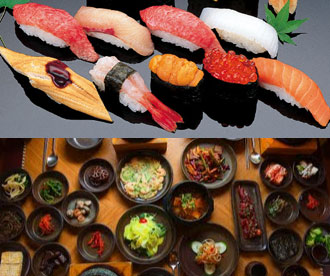The fact that most sushi restaurants in the US these days is run by Koreans reinforces my thesis that food provides the ultimate insight into their relative competitiveness in the global economy.
More than any other well-known Asian dish, sushi crystalizes my thesis. A piece of classic sushi comprises a translucent spear of fish overlaying a shaped mound of vinegared rice dabbed with a charge of wasabi. As typically served, it presents me with the choice of cramming whole an oversized mouthful or trying to bite off half and have the rice fall apart, leaving me to reassemble the remaining half of the fish with the broken rice mound.
I don’t want to look like a pig, even for the ten seconds it would take to chew and gulp the sushi, but I also don’t want to undertake the impossible task of reassembling half a piece of sushi. So I usually bite the sushi so that I get all the rice but leave almost half the fish. That gives me an almost civilized mouthful while leaving half the fish to be eaten like a piece of sashimi — which is why I almost never order sushi when there’s sashimi or some other dish.
What does this tell me about Japanese culture? That it puts a higher priority on the artistic and aesthetic satisfaction of the chef than on the convenience of the diner. A properly garnished platter of sushi is a feast for the eyes, something in which a chef can take satisfaction with each plate.
Why not make each piece of sushi bite-sized? It would not only look less aesthetic but would be more difficult and time consuming for the chef. In Japan the producer is king and the consumer is a mere accessory. Which is why Japanese live in tiny homes and work in absurdly cramped offices so obsolete traditional rice farmers can continue to impose their ridiculously overpriced rice and produce on urban consumers.
Korean food, on the other hand, puts the focus entirely on the consumer. For one thing, most Korean meals are ridiculously time consuming and tedious to prepare, with myriad side dishes comprising a dozen distinct textures and flavors. Compared with western fare, a typical traditional Korean meal is equivalent to a four- or five-course meal, with appetizers, a soup, a casserole or two, salads, a couple or three main dishes and a dessert. It takes a skilled home cook at least a couple of hours to prepare a typical dinner compared with say about 40 minutes for a typical American or Japanese meal. A Korean meal gives the diner complete latitude over what and how much to eat.
This explains why so many Korean restaurateurs have taken to opening sushi restaurants which are far less work and far more profitable. Some offer a discrete Korean dish or two, like kalbi or soondubu — neither of which are anywhere as demanding to prepare, serve or clean up after, as Korean dinners with all those side dishes.
This difference in attitudes toward the relationship between the producer and the consumer may also explain why Korea is inexorably gaining an upper hand over Japan in everything from smartphones to cars to pop music. To a large extent it’s that culture-based economic advantage that has forced Japan to go down the treacherous road toward printing massive amounts of yen in hopes of breaking the back of the yen and making exports more competitive against Korean rivals.

